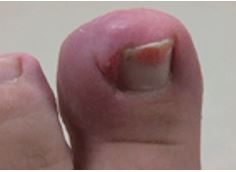Services: Ingrown Toe Nail Surgery

Some of the causes of Ingrown Nails (Onychocryptosis):
The primary risk factor is the shape of the nail - a nail that is more curved from side to side rather than being flat is more likely to become an ingrown nail. The shape of the nail is usually inherited (congenital), but it can be influenced by trauma and/or shoe pressure.
Poor cutting of nails- a sharp corner (or worse, a small spike) can be left that will initially cause symptoms by putting pressure on the skin and then later penetrate the skin. Trimming too far down the sides is a common cause of an ingrown toe nail.
Tight/pointy footwear increases the pressure between the skin in the nail fold and nail increasing the risk of an ingrown nail.
Are Antibiotics Necessary?
Antibiotics are often used to treat the infected ingrown toenail but don't forget that the cause of the infection (the ingrown nail) is still there, so there is not a lot of point in treating the infection while the cause remains. Sometimes antibiotics are used to help the infection clear after the nail has been removed. If the ingrown nail is treated quickly and the patient is in good health it is often possible to avoid the use of antibiotics.
Surgical Treatment of Ingrown Nails
If the ingrown nail is severe, if conservative care is difficult, or if the ingrown toe-nail does not respond well to conservative care, then minor surgical intervention is a good option. It is a very straight forward procedure that is performed by Matthew in the clinic. As a state registered Podiatrist with over 17 years experience, and having done 1000s of Nail Wedge resections his succes rates are very high (approximately 90% require no further intervention after successful surgery).
The surgical procedure (called a Partial Nail Avulsion (P.N.A) or a Nail Wedge Resection (N.W.R)) DOES NOT require the toe to be cut or stitched!!
The procedure takes approximately 1 hour and the patient is able to walk immediately afterwards. The procedure itself is performed under local anaesthetic via injection into both sides of the toe using a very fine gauge needle to minimise discomfort. Once the toe is numb a tight elastic ring called a tournicot is applied to the toe to control bleeding and the area is prepared to minimize the risk of infection. The offending portion of the nail is carefully removed and a chemical called Phenol is applied to the area to assist in preventing re-growth of the nail. Once the procedure is completed the tourniquet is removed and a sterile surgical dressing is applied. Comprehensive written and verbal advice will be given in order to prevent post-operative complications.
Generally, after the surgery you will need to keep your foot elevated for a few hours and rest is advisable for the remainder of the day. It is advisable not to drive for 12 hours after the procedure. The following day you can return to work or school. It is advisable not to take part in vigorous activities such as running until advised by the podiatrist. The use of an open toe shoe to reduce pressure on the area also facilitates healing.
Costs Involved
Please contact the clinic to discuss and receive a full itemised quote.

MAKE AN APPOINTMENT
Burleigh Osteopathic Clinic:
07 5568 7010

BURLEIGH OSTEOPATHIC
3/31 Connor Street,
Burleigh Heads, Qld 4220


